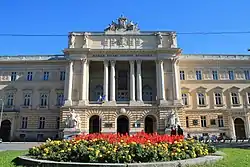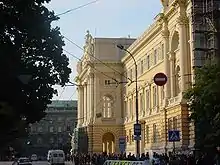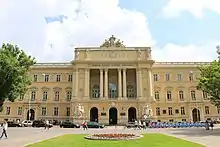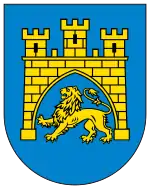University of Lviv
The University of Lviv (Ukrainian: Львівський університет, Polish: Uniwersytet Lwowski, German: Universität Lemberg, briefly known as the Theresianum in the early 19th-century), presently the Ivan Franko National University of Lviv (Ukrainian: Львівський національний університет імені Івана Франка) is the oldest university in Ukraine, dating from 1661 when the Polish King, John II Casimir, granted it its first royal charter. Over the centuries it underwent transformations, suspensions and name changes that reflected the geo-political complexities of this part of Europe. The present institution can be dated to 1940. It is located in the historic city of Lviv in Lviv Oblast of Western Ukraine.
Львівський національний університет імені Івана Франка | |
 | |
| Latin: Universitas Leopoliensis | |
Former names | Universität Lemberg Uniwersytet Jana Kazimierza (John Casimir University) |
|---|---|
Motto in English | Educated citizens – glory of the Motherland |
| Type | Public |
| Established | 1661 |
| President | Volodymyr Melnyk |
| Students | 11,649 |
| Location | , |
| Specialty programs | 111 |
| Colors | Blue and Gold |
| Website | www.lnu.edu.ua |
 | |
History
Beginnings
The university was founded on January 20, 1661, when King John II Casimir of Poland granted a charter to the city's Jesuit Collegium, founded in 1608, giving it "the honour of an academy and the title of a university". The Jesuits had tried to found a university earlier, in 1589, but did not succeed. Establishing another seat of learning in the Kingdom of Poland was seen as a threat by the authorities of Kraków's Jagiellonian University, which did not want a rival and which for many years managed to stymy the Jesuits' plans.
According to the Treaty of Hadiach (1658), an Orthodox Ruthenian academy was to be created in Kiev and another one in an unspecified location. The Jesuits suspected that it would be established in Lwów/Lviv on the foundations of the Orthodox Brotherhood's school, and used this as a pretext for obtaining a royal mandate that elevated their own college to the status of an academy (no city could have two academies).[1][2] King John II Casimir was a supporter of the Jesuits and his stance was crucial. The original royal charter was subsequently confirmed by another decree issued in Częstochowa on February 5, 1661.
In 1758 King Augustus III issued a decree, which described the Collegium as an academy, equal in fact status to the Jagiellonian University, with two faculties, those of Theology and Philosophy.
Austrian rule
In 1772 the city of Lwów was annexed by Austria (see: Partitions of Poland). Its German name was Lemberg and hence that of the university. In 1773 the Suppression of the Society of Jesus by Rome (Dominus ac Redemptor) was soon followed by the partition of the Polish-Lithuanian Commonwealth which meant that the university was excluded from the Commission of National Education reform. It was renamed Theresianum by the Austrians, i.e. a State Academy. On 21 October 1784 the Austrian Emperor Joseph II signed an act of foundation of a secular university.[3] He began to Germanise the institution by bringing German-speaking professors from the various parts of the empire. The university now had four faculties. To theology and philosophy were added those of law and medicine. Latin was the official language of the university, with Polish and German as auxiliary. Literary Slaveno-Rusyn (Ruthenian/Ukrainian) of the period had been used in the Studium Ruthenum (1787–1809), a special institute of the university for educating candidates for the Uniate (Greek-Catholic) priesthood.[4]
In 1805 the university was closed, as Austria, then involved in the Napoleonic wars, did not have sufficient funds to support it. Instead, it operated as a high school. The university was reopened in 1817.[3] Officially Vienna described it as an "act of mercy", but the actual reasons were different. The Austrian government was aware of the pro-Polish stance of the Russian Emperor Alexander I and the Austrians wanted to challenge it. However, the quality of the university's education was not considered high. Latin was replaced by German and most professors were mediocre. The few good ones regarded their stay in Lemberg as a springboard to other centres.
In 1848, when the pan-European revolution reached Lemberg (see: Revolutions of 1848), students of the university created two organizations: "The Academic Legion" and "the Academic Committee" both of which demanded that the university be polonized. The government in Vienna answered with force, and on November 2, 1848, the centre of the city was shelled by the troops led by General Hammerstein striking the buildings of the university, especially its library. A curfew was called and the university was temporarily closed. A major demand for Ukrainians was the education of teachers and promotion of Ukrainian culture through Ukrainian courses at the university and to this end a committee for the Defense of Ukrainian Education was created.[5]:58
It was reopened in January 1850, with only limited autonomy. After a few years the Austrians relented and on July 4, 1871 Vienna declared Polish and Ruthenian (Ukrainian) as the official languages at the university.[6] Eight years later this was changed. The Austrian authorities declared Polish as the main teaching medium with Ruthenian and German as auxiliary. Examinations in the two latter languages were possible as long as the professors used them. This move created unrest among the Ruthenians (Ukrainians), who were demanding equal rights. In 1908, a Ruthenian student of the philosophy faculty, Miroslaw Siczynski, had assassinated the Polish governor of Galicia, Andrzej Potocki.
Meanwhile, the University of Lemberg thrived, being one of two Polish language universities in Galicia, the other one was the Jagiellonian University in Kraków. Its professors were famous across Europe, with such renowned names as Wladyslaw Abraham, Oswald Balzer, Szymon Askenazy, Stanislaw Zakrzewski, Zygmunt Janiszewski, Kazimierz Twardowski, Benedykt Dybowski, Marian Smoluchowski and Ludwik Rydygier.
In the 1870s Ivan Franko studied at Lemberg University. He entered the world history as a well-known Ukrainian scholar, public figure, writer and translator. In 1894, the newly founded Chair of World History and the History of Eastern Europe was headed by Professor Mykhailo Hrushevskyi (1866–1934), an outstanding scholar of Ukrainian History, founder of the Ukrainian Historical School, and author of the ten-volume "History of Ukraine-Rus'", hundreds of works on History, History of Literature, Historiography, and Source Studies. In 1904, a special summer course in Ukrainian studies was organized in Lviv, primarily for Eastern Ukrainian students.[5]:124
The number of students grew from 1,732 in 1897 to 3,582 in 1906. Poles made up around 75% of the students, Ukrainians 20%, other nationalities 5%.[2] In mid-December 1910, Ukrainian women students at Lviv University established a Student Union's women's branch, their twenty members meeting regularly to discuss current affairs. In July 1912, they met with their Jewish counterpart branch to discuss the representation of women in the student body of the university.[5]:64
Jan Kazimierz University (1919–39)

During the Interbellum period, the region was part of the Second Polish Republic and the university was known as "Jan Kazimierz University" (since 1919[7]), Polish: Uniwersytet Jana Kazimierza, in honour of its founder, King John II Casimir Vasa. The decision to name the school after the king was taken by the government of Poland on November 22, 1919.
Jan Kazimierz University was the third biggest academic center in the country after the University of Warsaw and the Jagiellonian University in Kraków. On February 26, 1920, the university was rehoused by the Polish government in the building formerly used by the Sejm of the Land, which has since been the university's main location. Its first rector during the Second Polish Republic was the famous poet, Jan Kasprowicz.
In 1924 the Philosophy Faculty was divided into Humanities and Mathematics and Biology Departments, thus there were now five faculties. In the 1934/35 academic year, the breakdown of the student body was as follows:
- Theology – 222 students
- Law – 2,978 students
- Medicine – 638 students (together with the Pharmaceutical Section, which had 263 students)
- Humanities – 892 students
- Mathematics and Biology – 870 students
Altogether, during the academic year 1934/35, there were 5900 students at the university, consisting by religious observance of:
- 3793 Roman Catholics (64.3%)
- 1211 Jews (20.5%)
- 739 Ukrainian Greek-Catholics (12.5%)
- 72 Orthodox (1.2%)
- 67 Protestants (1.1%)
Ukrainian professors were required to take a formal oath of allegiance to Poland; most of them refused and left the university in the early 1920s. The principle of "Numerus clausus" had been introduced after which Ukrainian applicants were discriminated against – Ukrainian applications were capped at 15% of the intake, whereas Poles enjoyed a 50% quota at the time.[8]
Ivan Franko University
| University rankings | |
|---|---|
| Global – Overall | |
| THE World[9] | 1001+ (2020) |
In 1939, after the German invasion of Poland and the accompanying Soviet invasion, the Soviet administration permitted classes to continue. Until late 1939, the school worked in the pre-war Polish system. On October 18, however, the Polish rector, Professor Roman Longchamps de Bérier, was dismissed, and was replaced by a prominent Ukrainian historian, Mykhailo Marchenko, grandfather of Ukrainian journalist and dissident Valeriy Marchenko. Marchenko was determined to transform Jan Kazimierz University into the Ukrainian Soviet University.[10] On January 8, 1940, the university was renamed Ivan Franko Lviv State University.[10] Polish professors and administrative assistants were increasingly fired and replaced by Ukrainians or Russians, specializing in Marxism, Leninism, political economics, as well as Ukrainian and Soviet literature, history and geography.[10] This was accompanied by the closing of departments seen as related with the religion, free-market economics, capitalism, or the West in general; this included Polish geography, literature, or history.[10] Lectures were held in Ukrainian and Polish (as auxiliary). From 1939 to 1941, the Soviets also executed over a dozen members of the Polish faculty.[10]

In July 1941 the Nazi German occupiers closed the university, followed by the massacring two dozen Polish professors (as well as members of their households and guests, increasing the total number of victims to more than forty), who included members of other academic institutions, too.[10] The extent to which Ukrainian nationalists may have been involved in identifying and selecting some of the victims is still a matter of debate, as Polish historian Adam Redzik wrote, while the Ukrainian nationalist students helped prepare lists of Polish intellectuals, it is unlikely they expected or knew about their intended purposes (i.e., the executions).[10]
In the summer of 1944, the advancing Red Army, assisted by Polish Home Army forces locally implementing Operation Burza, pushed the Wehrmacht out of Lviv and the university reopened.[3] At first, its academic staff consisted of Poles, but within the following months most of them, together with the Polish population of the city, were "evacuated", i.e. expelled, as Stalin had moved Poland's borders far to the west. The traditions of Jan Kazimierz University have been preserved at the University of Wrocław, which was established replacing the University of Breslau after the German inhabitants of Breslau/Wrocław had been expelled following Stalin's establishing Germany's eastern border farther to the west.

The proclamation of the independence of Ukraine in 1991 brought about radical changes in every sphere of university life.[3] Professor, Doctor Ivan Vakarchuk, a renowned scholar in the field of Theoretical Physics, had been rector of the university since 1990 till 2013. Meeting the requirements arising in recent years new faculties and departments have been set up: the Faculty of International Relations and the Faculty of Philosophy (1992), the Faculty of Pre-Entrance University Preparation (1997), the Chair of Translation Studies and Comparative Linguistics (1998). Since 1997 the following new units have come into existence within the teaching and research framework of the university: the Law College, The Humanities Centre, The Institute of Literature Studies, The Italian Language and Culture Resource Centre. The teaching staff of the university has increased amounting to 981, with scholarly degrees awarded to over two thirds of the entire teaching staff. There are over one hundred laboratories and working units as well as the Computing Centre functioning here. The Zoological, Geological, Mineralogical Museums together with those of Numismatics, Sphragistics and Archeology are stimulating the interests of students.[8]
Faculties
- Faculty of Applied Mathematics and Informatics[11]
- Faculty of International Relations[12]
- Faculty of Biology[13]
- Faculty of Journalism[14]
- Faculty of Chemistry[15]
- Faculty of Law[16]
- Faculty of Economics[17]
- Faculty of Mechanics and Mathematics[18]
- Faculty of Electronics[19]
- Faculty of Philology[20]
- Faculty of Foreign Languages[21]
- Faculty of Philosophy[22]
- Faculty of Geography[23]
- Faculty of Physics[24]
- Faculty of Geology[25]
- Faculty of Preuniversity Training[26]
- Faculty of History[27]
- Department of Pedagogy[28]
- Department of Law[29]
Research divisions and facilities
- Scientific Research Department[30]
- Zoological museum[31]
- University Library[32]
- Journal of Physical Studies[33]
- The Institute of Archaeology[34]
- Ukrainian journal of computational linguistics[35]
- Media Ecology Institute[36]
- Modern Ukraine[37]
- Institute for Historical Research[38]
- Regional Agency for Sustainable Development[39]
- Botanical Garden[40]
- NATO Winter Academy in Lviv[41]
- Scientific technical & educational center of low temperature studies[42]
Notable alumni
- Roman Aftanazy (1914–2004), historian of culture, librarian, heritage rescuer
- Kazimierz Ajdukiewicz (1890–1963), philosopher, mathematician and logician, a pioneer of categorial grammar
- Piotr Ignacy Bieńkowski (1865–1925), classical scholar and archaeologist, professor of the Jagiellonian University
- Julia Brystiger (1902–1975), political militant, member of the security apparatus of the Polish People's Republic
- Józef Białynia Chołodecki (1852–1934), historian of Lviv.
- Ivan Franko (1856–1916), poet and linguist, reformer of the Ukrainian language
- Ludwik Fleck (1896–1961), medical doctor and biologist who developed in the 1930s the concept of thought collectives
- Stanisław Głąbiński (1862–1941) politician, professor and rector (1908–1909) of the university, lawyer and writer
- Georgiy R. Gongadze (1969–2000), Georgian and Ukrainian journalist
- Mark Kac (1914–1984), mathematician, pioneer of modern probability theory
- Yevhen Konovalets (1891–1938) leader of the Organization of Ukrainian Nationalists between 1929 and 1938.
- Emil Korytko (1813–1839), Polish philologist and ethnologist who worked in the Slovene Lands
- Stanisław Kot (1885–1975), scientist and politician, member of the Polish Government in Exile
- Tadeusz Kotarbiński (1881–1981), philosopher, mathematician, logician
- Pinhas Lavon (1904–1976), Israeli politician
- Raphael Lemkin (1900–1959), lawyer who introduced the term "genocide", an author of the United Nations' Convention on Genocide
- Antoni Łomnicki (1881–1941), mathematician
- Jan Łukasiewicz (1878–1956), mathematician
- Stanisław Maczek (1892–1994), commander of the First Polish Armoured Division, the last Commander of the First Polish Army Corps under Allied Command
- Kazimierz Michałowski (1901–1981), archeologist and Egyptologist
- Semyon Mogilevich (1946–), economist and mafia boss
- Bohdan Ihor Antonych (1909–1937), prominent Ukrainian writer
- Jan Parandowski (1895–1978), writer, essayist, and translator, expert on classical antiquity
- Stepan Popel (1909–1987), Ukrainian chess player and linguist
- Maciej Rataj (1884–1940), Polish politician, acting president
- Jaroslav Rudnyckyj (1910–1995), Ukrainian Canadian linguist, lexicographer, folklorist
- Hersch Lauterpacht (1897–1960), lawyer and Developer of the legal concept of "Crimes Against Humanity" in the Nuremberg Trials and writer of "An International Bill of the Rights of Man"
- Józef Schreier (1909–1943), mathematician
- Bruno Schulz (1892–1942), novelist and painter
- Markiyan Shashkevych (1811–1843), Ukrainian poet
- Zoia Skoropadenko (1978–), Ukrainian artist
- Josyf Slipyj (1892–1984), head of the Ukrainian Greek Catholic Church
- Louis B. Sohn (1914–2006), international law scholar and advisor, helped create the International Court of Justice, advisor to United States State Department, chaired professor at Harvard University and University of Georgia law schools in the United States
- Leonid Stein (1934–1973), grandmaster and Soviet Chess Champion
- Hugo Steinhaus (1887–1982), mathematician, educator, and humanist
- Julian Stryjkowski (1905–1996), Polish-Jewish journalist and writer
- Irena Turkevycz-Martynec (1899–1983), Ukrainian Opera Soprano
- Stefania Turkewich (1898–1977), Ukrainian composer, pianist, and musicologist
- Yuri Velykanovych (1910–1938), journalist, volunteer of the International Brigades
- Aizik Isaakovich Vol'pert (1923–2006), mathematician and chemical engineer
- Rudolf Weigl (1883–1957), biologist and inventor of the first effective vaccine for epidemic typhus
- Ivan Lysiak-Rudnytsky (1919–1984) — Ukrainian-Canadian historian, political scientist, publicist
Notable professors
- Henryk Arctowski (1871–1958), oceanographer, Antarctica explorer
- Szymon Askenazy (1866–1935), historian, diplomat and politician, founder of the Lwów-Warsaw School of History
- Herman Auerbach (1901–1942), mathematician
- Stefan Banach (1892–1945), mathematician, one of the moving spirits of the Lwów School of Mathematics, father of functional analysis
- Oswald Balzer (1858–1933), historian of law and statehood
- st. Józef Bilczewski (1860–1923), archbishop of the city of Lwów of the Latins
- Franciszek Bujak (1921–1941), historian
- Leon Chwistek (1884–1944), Avant-garde painter, theoretician of modern art, literary critic, logician, philosopher and mathematician
- Antoni Cieszyński (1882–1941), physician, dentist and surgeon
- Matija Čop (1797–1835), Slovene philologist and literary theorist
- Jan Czekanowski (1882–1965), anthropologist, statistician and linguist
- Władysław Dobrzaniecki (1897–1941), physician and surgeon
- Stanisław Głąbiński (1862–1941) politician, rector (1908–1909), lawyer and writer
- Yakiv Holovatsky (1814–1888), poet
- Mykhailo Hrushevsky (1866–1934), historian, organizer of scholarship, leader of the pre-revolution Ukrainian national movement, head of Ukraine's parliament, first president of Ukraine, who wrote an academic book titled: "Bar Starostvo: Historical Notes: XV-XVIII" about the history of Bar, Ukraine.[43]
- Stefan Inglot (1902–1994), historian.
- Zygmunt Janiszewski (1888–1920), mathematician,
- Antoni Kalina (1846–1905) ethnographer and ethnologist.
- Ignacy Krasicki (1735–1801), writer and poet, senator, Bishop of Warmia and Archbishop of Gniezno and Primate of Poland.
- Jerzy Kuryłowicz (1895–1978), linguist
- Karolina Lanckorońska (1898–2002), historian and art historian, Polish World War II resistance fighter
- Jan Łukasiewicz
- Ignác Martinovics (1755–1795) – physicist, Franciscan, Hungarian revolutionary
- Stanisław Mazur (1905–1981), mathematician
- Jakub Karol Parnas (1884–1949), (Russian: Яков Оскарович Парнас or Yakov Oskarovich Parnas). A Jewish-Polish–Soviet biochemist author of notable studies on carbohydrates metabolism in mammals. Glycolysis, a major metabolic mechanism, is universally named Embden-Meyerhoff-Parnas pathway after him.
- Eugeniusz Romer (1871–1954), cartographer
- Eugeniusz Rybka (1898–1988), astronomer, deputy director of the International Astronomical Union,
- Stanisław Ruziewicz (1881–1941), mathematician
- Wacław Sierpiński (1882–1969), mathematician, known for contributions to set theory, number theory, theory of functions and topology
- Marian Smoluchowski (1872–1917), scientist, pioneer of statistical physics and a mountaineer, creator the basis of the theory of stochastic processes
- Hugo Steinhaus (1887–1972), mathematician
- Szczepan Szczeniowski, physicist, author of numerous papers on cosmic rays,
- Kazimierz Twardowski (1866–1938), philosopher and logician, head of the Lwów-Warsaw School of Logic
- Tadeusz Boy-Żeleński (1874–1941), gynecologist, writer, poet, art critic, translator of French literary classics and journalist
- Rudolf Weigl biologist, Epidemiologist
- Aleksander Zawadzki, naturalist
- Viktor Pynzenyk, economist and politician
Other
- Włodzimierz Dzieduszycki (1825–1899), landowner, naturalist, political activist, collector and patron of arts
- Stanisław Lem (1921–2006), satirical, philosophical, and science fiction writer
- Ignacy Jan Paderewski (1860–1941) virtuoso pianist, composer, diplomat and politician, the third Prime Minister of Poland
- János Bolyai (1802–1860) The founder of noneuclidean (absolute) geometry. The highest figure of Hungarian mathematics worked at the University of Lviv from 1831 to 1832.
See also
References
- Isaievych, Iaroslav (2006). Voluntary Brotherhood: Confraternities of Laymen in Early Modern Ukraine. Canadian Institute of Ukrainian Studies. p. 153.
- Woleński, Jan (1997). "Lvov". In Poli, Roberto (ed.). In Itinere: European Cities and the Birth of Modern Scientific Philosophy. Rodopi. pp. 163, 165.
- "Lviv University – Internet Encyclopedia of Ukraine".
- Magocsi, Paul R. A history of Ukraine: the land and its peoples. University of Toronto Press, 2010. Pg. 425.
- Bohachevsky-Chomiak, Martha. Feminists Despite Themselves: Women in Ukrainian Community Life, 1884-1939. Canadian Institute of Ukrainian Studies, University of Alberta, Edmonton, 1988.
- Strauss, Johann. "Language and power in the late Ottoman Empire" (Chapter 7). In: Murphey, Rhoads (editor). Imperial Lineages and Legacies in the Eastern Mediterranean: Recording the Imprint of Roman, Byzantine and Ottoman Rule (Volume 18 of Birmingham Byzantine and Ottoman Studies). Routledge, 7 July 2016. ISBN 1317118448, 9781317118442. Google Books PT196.
- Dębiński, Antoni; Pyter, Magdalena (2013). "The role of Jan Kazimierz University in the process of development of legal studies at the Catholic University of Lublin (1918–1939)". Visnyk of the Lviv University. Series History. 49: 147.
- Brief history of L'viv University Archived 2013-05-13 at the Wayback Machine
- https://www.timeshighereducation.com/world-university-rankings/2020/world-ranking#!/page/0/length/25/locations/UA/sort_by/rank/sort_order/asc/cols/stats
- Adam Redzik, Polish Universities During the Second World War, Encuentros de Historia Comparada Hispano-Polaca / Spotkania poświęcone historii porównawczej hiszpańsko-polskiej conference, 2004
- "Головна". Ami.lnu.edu.au.
- "Головна". Intrel.lnu.edu.au.
- "Faculty of Biology of Ivan Franko National University of Lviv". Bioweb.lnu.edu.au.
- "Головна". Journ.lnu.edu.au. Retrieved 25 February 2019.
- "Хімічний факультет". Chem.lnu.edu.au.
- "Головна". Law.lnu.edu.au.
- "Економічний факультет ЛНУ". Econom.lnu.edu.au.
- "Механіко-математичний факультет Львівського національного університету імені Івана Франка". Mmf.lnu.edu.au.
- "Головна". Electronics.lnu.edu.au.
- "Головна". Philology.lnu.edu.au.
- "Головна". Lingua.lnu.edu.au.
- "Головна". Filos.lnu.edu.au.
- http://geograf.lnu.edu.ua Archived 2013-06-22 at the Wayback Machine
- "Головна". Physics.lnu.edu.au.
- "Головна". Geology.lnu.edu.au.
- "Головна". Ipodp.lnu.edu.au.
- "Головна". Clio.lnu.edu.au.
- "Archived copy". Archived from the original on 2012-07-09. Retrieved 2012-09-05.CS1 maint: archived copy as title (link)
- "Головна". Prk.lnu.edu.au.
- "Науково-дослідна частина". Research.lnu.edu.au.
- "Зоологічний музей Львівського національного університету імені Івана Франка". Zoomus.lnu.edu.au.
- "Archived copy". Archived from the original on 2018-07-15. Retrieved 2019-04-12.CS1 maint: archived copy as title (link)
- "Wrong address: Redirecting..." Ktf.lnu.edu.au.
- "Про нас". Lnu.lnu.edu.au.
- "Archived copy". Archived from the original on 2013-01-02. Retrieved 2012-09-05.CS1 maint: archived copy as title (link)
- "Archived copy". Archived from the original on 2012-12-22. Retrieved 2012-09-05.CS1 maint: archived copy as title (link)
- "Archived copy". Archived from the original on 2013-03-28. Retrieved 2012-09-05.CS1 maint: archived copy as title (link)
- "Archived copy". Archived from the original on 2012-12-22. Retrieved 2012-09-05.CS1 maint: archived copy as title (link)
- "Archived copy". Archived from the original on 2012-07-09. Retrieved 2012-09-05.CS1 maint: archived copy as title (link)
- Hrushevsky, M., Bar Starostvo: Historical Notes: XV-XVIII, St. Vladimir University Publishing House, Bol'shaya-Vasil'kovskaya, Building no. 29–31, Kiev, Ukraine, 1894; Lviv, Ukraine, ISBN 5-12-004335-6, pp. 1 – 623, 1996.
Literature
- Academia Militans. Uniwersytet Jana Kazimierza we Lwowie, red. Adam Redzik, Kraków 2015, ss. 1302.
- Ludwik Finkel, Starzyński Stanisław, Historya Uniwersytetu Lwowskiego, Lwów 1894.
- Franciszek Jaworski, Uniwersytet Lwowski. Wspomnienie jubileuszowe, Lwów 1912.
- Adam Redzik, Wydział Prawa Uniwersytetu Lwowskiego w latach 1939–1946, Lublin 2006
- Adam Redzik, Prawo prywatne na Uniwersytecie Jana Kazimierza we Lwowie, Warszawa 2009.
- Józef Wołczański, Wydział Teologiczny Uniwersytetu Jana Kazimierza 1918–1939, Kraków 2000.
- Universitati Leopoliensi, Trecentesimum Quinquagesimum Anniversarium Suae Fundationis Celebranti. In Memoriam. Praca zbiorowa. Polska Akademia Umiejętności, Kraków 2011, ISBN 978-83-7676-084-1
External links
- History of the University of Lviv to 1945 (in Polish)
| Wikimedia Commons has media related to University of Lviv. |
